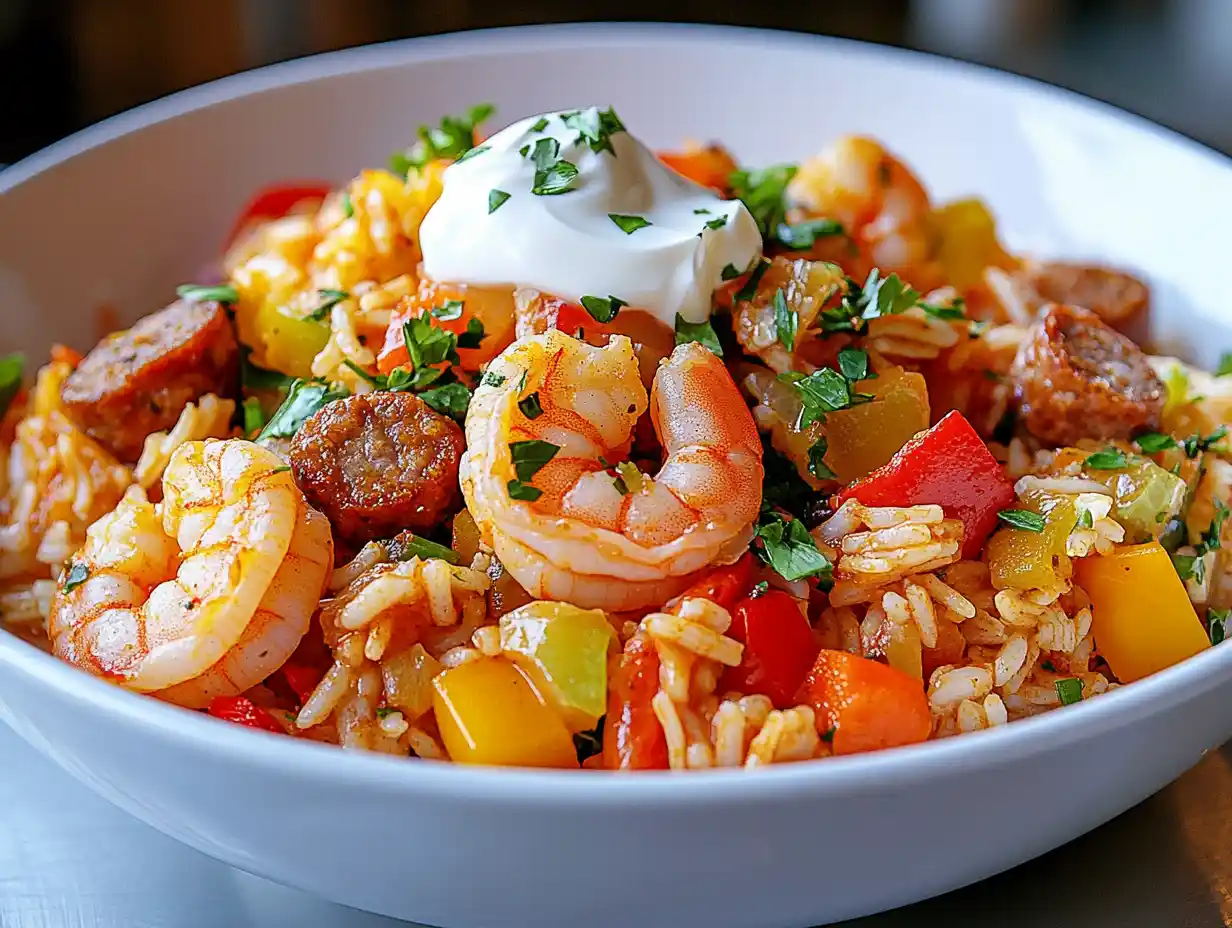Introduction
Jambalaya is celebrated for its hearty mix of rice, meats, vegetables, and spices, making it a versatile and satisfying meal. Adding sour cream to jambalaya might seem unconventional, but it can create a creamy texture and mellow the spiciness for those who prefer a milder taste. Sour cream’s tangy profile often complements bold and savory dishes, raising the question of whether it could enhance this Cajun and Creole classic. While traditionalists may hesitate, food lovers eager to experiment might find this addition worth exploring. In this guide, we’ll dive into the possibilities, pros, and techniques for incorporating sour cream into jambalaya.
What is Jambalaya?
Jambalaya is one of Louisiana’s most famous dishes, loved for its rich flavors and hearty ingredients. It’s a vibrant one-pot meal that reflects a unique blend of French, Spanish, and African culinary influences. Packed with rice, meat, seafood, vegetables, and bold spices, jambalaya is as diverse in its variations as it is flavorful.
The dish typically falls into two main categories: Creole and Cajun. Creole jambalaya, also known as “red jambalaya,” incorporates tomatoes, giving it a slightly sweet and tangy flavor. Cajun jambalaya, on the other hand, is more rustic, without tomatoes, and often features a smoky, earthy taste. Both styles, however, emphasize bold seasonings and the use of what’s locally available, making it adaptable yet iconic.
Traditional Ingredients of Jambalaya
At its core, jambalaya starts with what Louisianans call the “Holy Trinity” of cooking—onions, bell peppers, and celery. These vegetables form the base of the dish, adding depth and aroma to every bite.
Proteins are the star of the show, with chicken, sausage (like andouille), and shrimp often taking center stage. Smoked sausage brings a savory kick, while seafood adds a fresh and briny note. For added richness, some cooks include other meats like ham or even crawfish.
The rice is another key ingredient, absorbing all the spices and juices from the meat and vegetables as it cooks. Bold seasonings like cayenne pepper, paprika, thyme, and bay leaves are used generously, creating a dish that’s not just flavorful but deeply satisfying.
Key Flavor Profile of Jambalaya
Jambalaya is all about balance—spicy, smoky, and savory flavors come together harmoniously. The dish often has a mild to moderate heat level, but it can easily be adjusted to suit your taste buds. Its texture is equally important; the rice should be tender yet distinct, and the combination of meats and vegetables should feel hearty and well-blended.
This complex flavor profile is part of what makes jambalaya so special. It’s deeply rooted in tradition but flexible enough to welcome creative twists, like the possible addition of sour cream. Speaking of which, let’s explore the role of sour cream and how it might fit into this classic dish.
3. What is Sour Cream, and How Is It Used in Cooking?

Sour cream is a versatile ingredient with a creamy texture and tangy flavor that’s made by fermenting regular cream with lactic acid bacteria. This fermentation process gives it its signature sour taste while thickening the cream into a velvety consistency. A staple in many kitchens, sour cream is known for its ability to enhance both sweet and savory dishes.
3.1 Common Culinary Uses of Sour Cream
Sour cream’s rich and tangy profile makes it a favorite for enhancing various recipes. It is often used as a topping for baked potatoes, nachos, and chili to add creaminess and balance spicy or bold flavors. In baking, sour cream is prized for making cakes and muffins moist and tender. When stirred into soups, stews, or dips, it adds a luxurious texture that elevates the dish.
It’s also a popular ingredient in international cuisines. For instance, in Eastern European cooking, sour cream is a classic addition to borscht and stroganoff, while in Mexican cuisine, it serves as a cooling complement to dishes like tacos and enchiladas.
3.2 Compatibility of Sour Cream with Savory Dishes
What makes sour cream so versatile is its ability to blend seamlessly into savory dishes without overpowering their existing flavors. Its acidity balances rich, fatty ingredients, while its creaminess mellows spicy or sharp tastes. These qualities make it a natural companion to many foods, including those with bold seasoning—much like jambalaya.
However, adding sour cream to jambalaya introduces a twist to the traditional recipe. It softens the heat and adds a touch of creaminess that may or may not align with your flavor goals. Let’s explore whether this addition makes sense for this iconic dish.
Adding Sour Cream to Jambalaya: Is It a Good Idea?
The idea of adding sour cream to jambalaya sparks mixed opinions among chefs and food lovers. Jambalaya, with its bold and spicy profile, is deeply rooted in tradition, but there’s always room for innovation in the kitchen. Whether sour cream complements or detracts from this dish depends largely on your taste preferences and the way it’s incorporated.
The Culinary Perspective
From a culinary standpoint, sour cream can add creaminess and a slight tang that balances the spiciness of jambalaya. This may appeal to those who prefer milder flavors or enjoy creamy textures in their dishes. When stirred in at the end of cooking, sour cream can create a velvety finish that enhances the dish’s overall appeal.
However, it’s worth noting that sour cream alters the traditional flavor profile of jambalaya. It dilutes the bold spices and may mask the smoky undertones from ingredients like andouille sausage or smoked paprika. For purists who value authenticity, this might be a drawback.
Pros and Cons of Adding Sour Cream
Pros:
- Creaminess: Adds a smooth, rich texture to the dish.
- Cooling Effect: Reduces the heat level for those sensitive to spice.
- Unique Twist: Offers a fresh take on traditional jambalaya.
Cons:
- Flavor Alteration: Mutes the signature bold and spicy flavors.
- Texture Concerns: If added improperly, sour cream can curdle, especially at high temperatures.
- Tradition: Strays from the classic jambalaya recipe, which might not appeal to everyone.
Alternative Ingredients to Sour Cream
If sour cream doesn’t seem like the right fit but you still want to experiment with creamy additions, there are other options to consider.
Yogurt: Greek yogurt is a great substitute, offering similar tanginess with a thicker consistency. It’s also slightly less rich, which can be a plus for lighter dishes.
Crème Fraîche: This French staple is similar to sour cream but with a milder flavor and a silkier texture. It’s less prone to curdling, making it a reliable choice for hot dishes.
Heavy Cream or Milk: For those who want to avoid tanginess altogether, heavy cream or milk can add creaminess without changing the dish’s flavor profile drastically.
How to Add Sour Cream to Jambalaya Properly

If you’re ready to give sour cream a try in your jambalaya, it’s important to know the best way to incorporate it without compromising the dish. A little care in preparation can make all the difference, ensuring the addition enhances rather than detracts from your meal.
Best Techniques for Incorporating Sour Cream
When adding sour cream to jambalaya, timing and technique are key. Sour cream is delicate and can curdle if exposed to high heat for too long. To avoid this, always add it at the end of the cooking process or use it as a topping.
1. Stir It In Gently: Once your jambalaya is fully cooked and removed from direct heat, stir in a few dollops of sour cream. The residual heat will warm the sour cream without causing separation, creating a creamy consistency.
2. Serve It on the Side: If you’re unsure about how sour cream will work with the dish, serve it as a topping or alongside the jambalaya. Guests can add it to their portions as they see fit, offering more flexibility.
3. Tempering for Smooth Results: To avoid curdling, temper the sour cream before adding it to the dish. This involves mixing a small amount of hot broth or sauce from the jambalaya into the sour cream to gently raise its temperature. Once tempered, you can safely incorporate it into the main dish.
Recipes and Serving Suggestions
Sour cream can work wonderfully in certain variations of jambalaya, especially those that lean toward creamier or less traditional takes on the dish. Here are some creative ideas:
Creamy Cajun Jambalaya: For a creamy version of this classic, add sour cream along with a touch of heavy cream or cheese. This works particularly well in Cajun-style jambalaya, where the smoky flavors of sausage and spices are complemented by the richness of the cream.
Spicy Shrimp Jambalaya: Sour cream can be the perfect accompaniment to a seafood-heavy jambalaya. It balances the spice and adds a cool contrast to the heat from the seasoning.
Family-Style Serving: Use sour cream as a garnish, along with other toppings like fresh parsley, green onions, or shredded cheese. This allows everyone to customize their plates to their liking.
By experimenting with these techniques and variations, you can decide if sour cream is a hit or miss for your version of jambalaya.
FAQs About Jambalaya and Sour Cream
Let’s address some common questions about combining sour cream with jambalaya and other Cajun or Creole dishes.
Does adding sour cream make jambalaya less spicy?
Yes, sour cream has a natural cooling effect that can reduce the heat of spicy dishes. Its creamy texture helps to mellow bold seasonings, making it a great choice for those who prefer milder flavors.
Can sour cream replace any traditional ingredient in jambalaya?
Not really. Sour cream is more of an addition than a replacement. It doesn’t substitute core ingredients like rice, vegetables, or proteins but serves as a complementary element for added creaminess.
What are some popular jambalaya variations?
Jambalaya comes in many forms, from seafood-heavy versions with shrimp and crawfish to chicken-and-sausage combinations. Some cooks add tomatoes for a Creole touch, while others prefer the simplicity of the Cajun style. Creamy jambalaya is another twist that incorporates ingredients like sour cream or cheese.
Can you add sour cream to other Cajun dishes?
Absolutely! Sour cream pairs well with other Cajun recipes like gumbo, étouffée, or even red beans and rice. Its cooling effect and creamy consistency can complement bold and spicy dishes beautifully.
What other toppings go well with jambalaya?
Jambalaya can be topped with a variety of ingredients, including fresh herbs like parsley, diced green onions, grated cheese, or even a squeeze of lemon juice. Each option enhances the dish in its own way, offering more complexity and flavor.
Conclusion
Jambalaya is a beloved dish that brings bold flavors, hearty textures, and a rich cultural history to the table. While traditional recipes are celebrated for their authenticity, adding ingredients like sour cream can offer a creative twist that personalizes the dish. Sour cream’s creamy texture and tangy flavor can balance the heat and enhance the overall dining experience, making it a worthwhile addition for some.
However, adding sour cream isn’t without its challenges. It’s important to consider how it might alter the dish’s traditional profile and whether this aligns with your preferences. By incorporating it thoughtfully—either stirred in gently, served on the side, or tempered—you can enjoy the benefits without compromising the integrity of the meal.
Ultimately, whether to add sour cream to jambalaya is a matter of personal taste. If you’re curious, don’t hesitate to experiment. Cooking is, after all, about exploration and finding what works for you. So grab your pot, gather your ingredients, and let your creativity shine as you craft your perfect version of jambalaya—sour cream or not!
If you’re exploring sour cream in jambalaya, you might enjoy our guide on what goes good on jambalaya for pairing tips. For a different twist, check out our recipe for jambalaya with cheese to add a creamy texture. Lastly, discover the difference between gumbo and jambalaya to enhance your understanding of these classic dishes!

